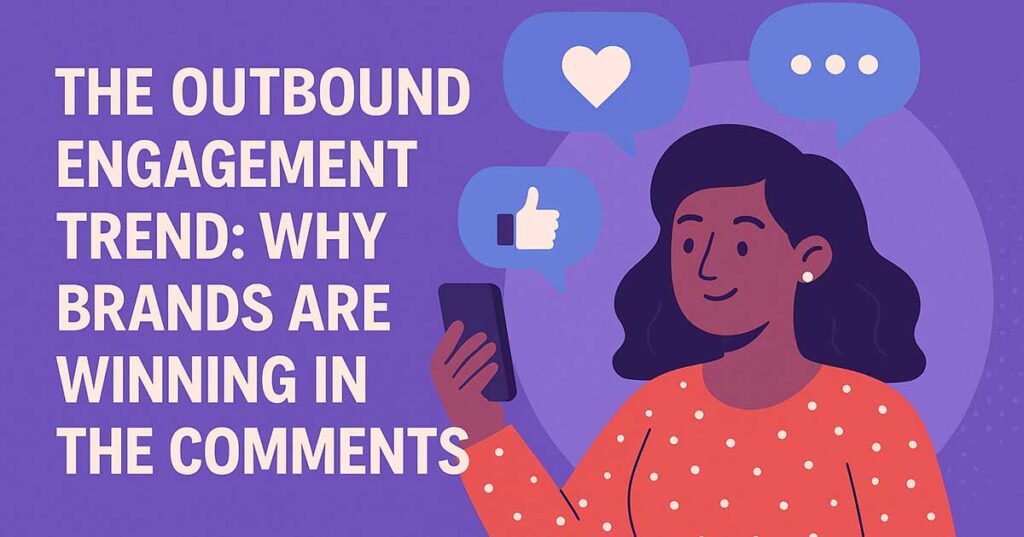If you’ve spent any time on Instagram, TikTok, or LinkedIn lately, you’ll notice something: brands aren’t just posting on their own feeds anymore; they’re showing up in the comments section of other people’s content.
That’s outbound engagement. And while it might look like “just leaving a comment,” the brands that are doing it well are playing a much bigger game. They’re building relationships, expanding visibility, and inserting themselves naturally into conversations where their audiences already are.
I’ve used outbound engagement across multiple campaigns, and trust me, when it’s done strategically, it’s one of the most cost-effective ways to get noticed in 2025.
What Outbound Engagement Really Is
Outbound engagement means your brand is actively commenting on creators’ content to connect with new audiences, not just waiting for people to discover you.
But here’s the catch: it only works if you do it with intention. Audiences can spot lazy comments (“Great post!! 🔥🔥🔥”) from a mile away. Thoughtful engagement, on the other hand, can open doors to new communities, strengthen credibility, and start meaningful relationships with creators.
Why Outbound Engagement Matters in 2025
Social media has never been more crowded. Algorithms reward content that sparks conversations, and audiences reward brands that feel authentic. Outbound engagement hits both:
- Expand brand visibility – appear in high-traffic comment sections, not just your own feed.
- Build credibility – show you understand the conversation and add value.
- Attract new audiences – people who’d never otherwise see your brand.
- Strengthen creator ties – creators notice and appreciate genuine brand interactions.
Sprout Social’s research shows consistent outbound engagement increases both brand visibility and consumer trust. And from my own experience? It works best when you treat it as a relationship-building exercise, not a numbers game.
The Rules of Effective Outbound Engagement
Here’s what separates winning comments from forgettable ones:
- Timeliness matters – Comments within 24 hours of a post landing perform best. After that, the buzz dies down.
- Keep it short but smart – 10–99 characters is the sweet spot. Emojis alone can look lazy, while long paragraphs can lose their punch.
- Relevance is everything – Don’t force your brand into the conversation. Add value that connects authentically.
Good vs. Poor Outbound Engagement
| Approach | Good Engagement Example | Poor Engagement Example |
| Tone | “Love the insight – aligns with how we help clients too 👌” | “Great post!! 🔥🔥🔥” |
| Length | 40 characters – short, but thoughtful | 5 characters – “👍👍” |
| Relevance | Comment ties the brand to the topic in context | Random comment, no connection |
| Timing | Within 12 hours of post | 3+ days later, when the conversation is over |
Want to Grow Your Brand on Social Media?
Social media is where your customers spend their time — the question is, are you reaching them effectively? At Digital Hype, we manage and optimise campaigns across Facebook, Instagram, LinkedIn, TikTok and more. From content creation to paid ads, we help businesses across Bournemouth, Poole, Dorset and UK-wide build engagement, grow followers, and convert likes into customers.
Contact Our Social Media ExpertsHow We Run Outbound Engagement at Digital Hype
When I manage outbound engagement for clients, it’s never random. Here’s the process our Digital Hype social media marketing team uses:
- Target the right creators and communities – We map out where your audience spends time.
- Monitor content in real-time – Tracking posts as they go live, so your comments land early.
- Craft strategic comments – 10–99 characters, brand-aligned, value-driven. Example: a Dorset café might comment, “Love the latte art — our baristas would approve ☕✨”.
- Build consistency – Engaging regularly so your brand becomes familiar in community conversations.
- Foster deeper ties – We don’t stop at comments; we re-share content, initiate partnerships, and support creators in the long term.
- Measure and refine – Tracking impressions, reach, and follower growth to keep improving.
For businesses in Bournemouth, Poole, Dorset, and the UK, this approach strikes a balance between visibility and credibility, exactly what audiences expect in 2025.
Moving Beyond Comments
Here’s the truth: comments are just the start. Creators are becoming more selective about the brands they interact with. To stand out, outbound engagement must be part of a broader relationship strategy. Brands that approach it strategically will build credibility and community, not just impressions.
If you want your social presence to feel authentic, our social media campaign services and content marketing expertise can help turn outbound engagement into long-term audience growth.
FAQs About Outbound Engagement
1. What is outbound engagement in marketing?
It’s when brands comment strategically on creators’ posts to increase visibility and connect with new audiences.
2. Why is timeliness so important?
Engagement drops dramatically after 24 hours; it’s all about being part of the live conversation.
3. Does comment length really matter?
Yes. A range of 10–99 characters has been proven to drive stronger interaction.
4. Can small businesses use outbound engagement?
Definitely. It’s one of the most budget-friendly ways to grow visibility.
5. What risks are there?
Lazy, generic comments can harm credibility and make your brand look inauthentic.
6. Which platforms does it work best on?
Instagram, TikTok, LinkedIn, and Twitter/X.
7. How does it support broader strategies?
It complements content creation, influencer campaigns, and community management.
8. How does Digital Hype help?
Our account managers craft smart comment strategies, execute them authentically, and measure impact for long-term ROI.
Staying Human While You Scale
Outbound engagement is proof that small touches can make a big difference. Yes, algorithms reward it. But more importantly, people notice when brands show up with thought and authenticity.
In 2025, the brands that win won’t be the ones shouting the loudest. They’ll be the ones who naturally join conversations, build trust, and leave a trail of meaningful interactions. That’s what turns comments into communities.


